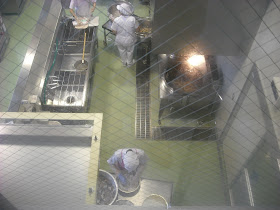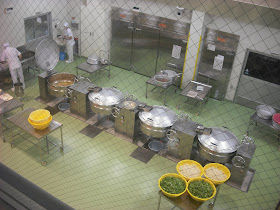Today, I visited the Kyushoku Center like
I did last year.
今日は、去年と同じく給食センターに行ってきました。
Today's menu was:
Rice
Milk
Miso kenchin soup with eggplant
Horse mackerel with vegetable an kake
Kiriboshi daikon dressed with sesame seeds
and vinegar
Cherry tomatoes
今日の献立は
ご飯
牛乳
なすのみそけんちん汁
アジの野菜あんかけ
切干大根のごま酢あえ
ミニトマト







I wish American public school lunches were even half as healthy as this.
ReplyDeleteThe same for me! I don't think I ever once saw a meal quite this balanced when I was in school.
ReplyDeleteHow was the taste?
ReplyDeleteThanks everyone for their comments.
ReplyDeleteThe aji fry was tasty, but the soup and the daikon aemono were rather bland. I learned from the teacher yesterday that kyushoku is limited to 2.5 g salt per meal. No wonder that the meal was rather bland.
No wonder east asian people are that slim. This looks very healthy and low calory I suppose. Is there any reason for limiting salt content?
ReplyDeleteOur schools have to learn quite a bit from other cultures: The food is way too heavy and on the cheap side. They are limited to 2.50 Euro for each meal - guess what's on the plate: carbs and fat.
Those lunches look so much better than what we get in school in Canada. Even at my college, the food is overpriced and lacks nutrition with portions that are too large, fatty, and salty. Even though the schools pay lip service to parents by promising healthier food choices in school, what it really means is that soft drinks are replaced by sugary flavoured milk and expensive Vitamin Water. In the cafeteria, it is still nothing but pizza, hamburgers, and fried chicken. At my college, lunch can cost $10 every day and is nothing but empty calories and grease.
ReplyDeleteI would honestly say that Japan's food program is something to be envied by North America. I think bland food is at least better than fatty, greasy food with 2000mg of sodium.
Kiki: Not only salt but also calories are limited (3 g and 850 kcal, respectively). Fat is limited to 20-25% of the energy. There are also reference values for other nutrients.
ReplyDeleteThe cost of that day's lunch was 307 yen per meal. Note that under the School Lunch Law of Japan, the cost of ingredients shall be borne by the guardians, while other costs (equipment, labor, etc.) shall be borne by the municipality.
Joanna: $10? Sounds rather expensive for college students. In Japan, decent meals are offered for well less than 500 yen at a gakushoku (school cafeteria).
Joanna: $10 for a relatively non-nutritive meal is the norm here in Central Texas as well.
ReplyDeleteHiroyuki: If you have an interest, I grew up in and around the routinely fattest "city" in the United States: Huntington, West Virginia. Our school system was run on a county level (similar to if they were ward level around Tokyo, I would think), and other than basic government guidelines, the food was expected to be cheap and filling.
There were no salt, fat, or ingredient guidelines while I was in school. An average lunch room set of lines for my 2,500+ student school was divided between a few options:
1) Sandwich line (usually burgers and fried chicken) w/ fries or crisps
2) Main line (closest to a balanced meal), changing daily.
3) Pizza line (cheese, pepperoni, or beef sausage), with fries again.
4) "Salad Bar" (changed daily, more often meatballs, chicken wings, tacos, and high-fat stews with veggies available as an after thought)
5) "Quick" line (in a separate end of the building - pizza and burgers with no sides)
As an added oddity, there was a soft-serve ice cream machine that operated twice weekly. All of this was included for about $2. If you weren't even remotely active, you averaged 8 kilograms of weight gain a year at that school.
The university in Huntington served much the same kinds of food, but charged us something close to $8 a plate, especially if you wanted anything remotely healthy like yogurt, tinned fruits, or *gasp* a vegetarian meal.
Ruminating Roy: Wow, thanks for your very detailed description!
ReplyDeleteI think I have to post about the situation in Japan in the near future.
In American schools, they technically have to serve 'balanced' meals... but then they manipulate the rules... like, potatoes are considered vegetables, even if they are fried, or the tomato sauce on pizza is considered a vegetable. I remember going to my former stepkids' school to have lunch with them. I was shocked! They had processed potato cakes (called potato "smileys"), breaded processed chicken nuggets and a carton of chocolate or regular milk. No veggies. There was a bowl containing a couple of sad apples and bruised banana for the children to grab. (none of them did) But it was uncut fruit, not nearly enough for each child to have a serving, and was sat on top of the glass "sneeze guard", so most of the kids were too short to reach it.
ReplyDeleteWhen I went to school, we had vegetables at every meal... granted it was usually canned corn or green beans, but at least veggies were served. I think a large part of the declining grades of American students (as well as hyperactivity and poor behavior) can be attributed to poor nutrition, It's would solve all of the problems, but simply improving the meals that they serve in public schools would make a big difference.
Sorry, I'm off my soapbox now. (smile)
muskratbyte: Thank you for your contribution.
ReplyDeleteIn Japan, it is said that the reason why many young people nowadays get angry so easily (sugu kireru すぐ切れる in Japanese) is that they lack calcium. I don't know whether this is true, but I think we all agree that a well-balanced meal is good for both body and mind.